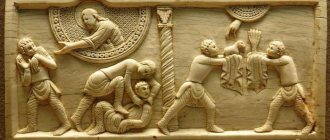Place me like a seal on your heart, like a ring on your hand: for love is strong as death; fierce, like hell, jealousy; her arrows are arrows of fire; she has a very strong flame. Great waters cannot extinguish love, and rivers cannot drown it. If someone gave all the wealth of his house for love, he would be rejected with contempt.
The Song of Songs has long been a closed book for many people due to difficulties in its interpretation. If this book teaches what true marital love is from a divine perspective, which it certainly seems to be, then why the main character Solomon? Most of us hardly think of Solomon as a model for monogamous marriage!
Also, where do we find the right key to understand the book? Is there any place where the narrative, play, drama or poem (whichever it is) comes to some kind of focus and gives the reader a clue to interpretation?
The answer, I believe, can be found in Song of Songs 8:6-7. The pronominal suffixes from the Hebrew text here are all clearly masculine; therefore, the speaker is the maiden Shulamite (Shulamit). She turns to her lover, the person to whom she has sung praises and whom she loves.
Not all scientists agree on who this man is. Most, in recent times, take him for the same one who composed the Song of Songs under the inspiration of God—Solomon. But I think the best case is to involve the presence of a third character, to whom this young woman swore her love a few months ago. Meanwhile, Solomon saw her and tried to get her to become part of his growing harem. The Shulamite refused, despite the persistent requests of the other women. They thought that she would “get her way” if only she gave in to the king’s offer of love.
But the girl could not forget the shepherdess, to whom she was promised, for whom she was a great love. It is to him that she addresses these lines. And this love that they had for each other is the means by which Solomon learned, with the help of the Spirit of God, about true marital love. Someone who had loved and lost so much was now the recipient of God's normative pattern for love, sex, and marriage.
These verses mark the completion of the book and thus show us the purpose for which it was written. Addressing her lover as the one whom she met under the apple tree and who awakened love in her for the first time, she asks to be placed as a seal on a cord around her neck and as a signet ring on her hand, to be his wife forever . The signet ring was worn either on the hand (Gen 41:42; Esther 3:12; Jeremiah 22:24) or around the neck with a rope through it (Gen 38:18). The seal was a sign of ownership and power. The typical Israeli name seal was made of stone, often with a hole punched in it, and worn around the neck on a cord, and sometimes on the finger as a ring. Several personal seals with the words “wife of so-and-so” have been found in Israel. Thus, the Shulamite pleads for a unique relationship to be chosen by him and belong to him forever.
The love she describes has five elements that make it distinctive. First of all, it is as strong as death. Her power is as indestructible and insurmountable as death itself. It cannot be resisted or denied, so it can only be compared to death - who has ever successfully withstood its power?
Secondly, her jealousy is as adamant as the grave. The word jealousy has both positive and negative meanings in the Bible. Used positively, in relation to God (Ex. 20:5; 34:14; Deut. 5:9), it implies undivided devotion to its object, an ardent love that does not tolerate rivals and demands undivided attention in return. It is used in this sense in the Song of Songs, indicating love that is jealous of someone, not from someone. Thus, it is a manifestation of genuine love and care. She is “cruel” or “tough” too - adamant and decisive in her desire to be with her beloved. To what extent will this love reach, because it is deep, inexorable and solid, like the grave.
Thirdly, this love burns with the flame of fire given by the Lord himself. The word "flame" has, in Hebrew, the suffix yaÆh, which should be understood as a shortened form of the name Yahweh, the Lord. This means that this love does not come from some carnal instinct, it comes from the Lord Himself! He is the true source of marital love. The flame of love in the heart of a man or woman is illuminated by the Lord who created them. And within marriage, this flame of love comes from the Lord.
Fourthly, this love cannot be drowned out by a large amount of water or even a flood. Solomon had to forget to woo Shulamite, despite all his promises, position, jewelry, wealth and pleasure could not drown out her love for this shepherd boy.
Finally, such love goes beyond any price offered anywhere. This is the victorious side of love, and it comes from God; it cannot be bought or sold. This will not end with the custom of paying a “bride price.” Such a payment was never interpreted as a payment “for love”, nor was it used to receive love. The point is precisely that God's true love for a man or woman has no price.
Thus, this text glorifies physical love within marriage for its power, its insatiable nature and its source - the Lord Himself.
Hard Sayings of the Bible
LOVE IS STRONG AS DEATH
To the table of contents “Articles for the weekly portions of the Torah”
Commentary on the Torah
Arie Baratz
The deceit of platonic love Love is strong as death Natural religion
The deceit of platonic loveThe Shabbat Torah reading, which falls on Chol Hamoed Pesach, pushes back the regular weekly reading, and a different passage is read in its place. However, besides it, on this Saturday in synagogues they also read the “Song of Songs,” to which, in continuation of the previously raised topic of “Jewish Kama Sutra,” it is quite appropriate to address.
The sages doubted whether to include this seemingly purely poetic love poem in the collection of sacred books TaNakh. A positive solution to this issue involuntarily pushes to radical conclusions.
But it must be said that Judaism is not only imbued with sexual imagery, but also proceeds from sexual differentiation as something fundamental. According to Judaism, sexual differentiation lies both at the foundation of man and the cosmos, and at the foundation of the Most Holy One himself and His Shekinah (I discuss this issue in some detail in my book “The Presumption of Humanity”*).
Of particular interest, however, is the nature of the “platonic correspondence” between marital and religious unions. What, in fact, can we find special in the love relationship between a man and a woman in order to compare it to the relationship between the Most Holy One and Israel?
Before answering this question, it is worth revisiting the ambiguous status of Platonism in the Jewish tradition. The dispute I mentioned at one time between Plato, who considered the world of ideas to be the only real world, and Aristotle, who denied the independent existence of the ideal world, made itself felt in the Jewish world in the late Middle Ages.
A consistent Aristotelian was R. Moshe ben Maimon (Rambam) (1135-1204). His approach naturally met with a platonic reaction. R. Moshe ben Nachman (1194-1270) and his relative, R. Yona from Gerona, opposed Rambam. Soon other Jewish religious authorities became embroiled in this controversy between philosophers and mystics.
At first, the litigants still looked relatively equal. However, after the appearance of the Zohar (which began to circulate in copies from 1290), the Platonic Kabbalistic approach clearly prevailed.
The dispute continued for some time. For example, the 14th-century Aristotelian philosopher Rabbi Eliyahu b. Eliezer Iskandi accused the mystics of the fact that their proposed interpretation of the ten sefirot encroaches on the unity of God (I note in passing that the “ten” is well known to Neoplatonism). Meanwhile, the arguments of the philosophers were ignored by the mystics, Platonized Kabbalah took possession of the minds of contemporaries, and after Rabbi Isaac ben Shlomo Luria (Arizal) (1534-1572) it entered Jewish life like a master.
The Aristotelian approach, which completely emasculated individual religious realities, could not satisfy the needs of the religious soul. It is indeed difficult for religion to do without Plato. However, the Arizalian “Platonic answer” contained many ambiguous pantheistic elements, which were not slow to manifest themselves in openly heretical teachings, in particular in Sabbatianism.
But it is interesting that on the issue of love imagery, perhaps no fundamental dispute arose between the Jewish Aristotelians and Platonists. In the case of marriage imagery, both sides, accepting or not accepting Plato’s external approach, at the same time argue with him on the merits.
After all, so-called “platonic love” is love exclusively for the masculine principle. “Looking at the beauty of the boy... the soul is carried away and receives warmth, feels relief from sorrow and rejoices” (Phaedrus). In other words, Plato's eros is a homosexual, extramarital eros. At the same time, it is also significant that Plato’s ideas not only live in isolation from the material world, but are also recognized as the only reality. For Plato, the material world is, if not Buddhist “maya,” then at least the boundary of reality.
In Judaism, love is necessarily heterosexual, and physicality is religiously meaningful. Thus, the meaning of sexual relations, as they are understood in “Jewish Platonism,” is that loving souls make their way to each other through bodies. But this means that these ideal souls draw matter into their value field, and thereby, as it were, redeem it.
In this regard, the teachings of the remarkable Jewish thinker Emmanuel Levinas deserve special attention.
Love is strong as death
Emmanul Levinas was born in 1906 in Kaunas, where he received a Jewish education. In 1923, the Levinas family moved to France, where Emmanul studied philosophy. In 1940, after the occupation of France by the Nazis, Levinas ended up in a concentration camp, where he remained until the defeat of Nazi Germany. Almost his entire family, who remained in Lithuania, died at the hands of the Nazis. Since 1957, Levinas taught classes in the study of the Talmud. He wrote many books, both dedicated to Judaism and touching upon general philosophical problems.
Levinas's approach is consistently anti-Platonic: “The modern philosophy of meaning,” writes Levinas, “whether it goes back to Hegelian, Bergsonian or phenomenological roots, is in one fundamental point opposed to Plato; the comprehensible is unthinkable outside the formation that prompted it... The world of meaning precedes him (Plato) expressing his linguistic activity and culture... Modern philosophical anti-Platonism consists precisely in the subordination of the intellect to expression.”
However, this statement is only partly true. In addition to culture, there is also nature. In any situation, in addition to the cultural “variable,” there is also a natural “constant.” Under the clothes, which reflect the area and era, sometimes with an accuracy of a kilometer and a year, lies a naked body, which in its essence is no different between the ancient Greeks and the modern English. And in the members of this body, as well as in its needs, it is natural to discern meanings, in particular, the meaning of marital relations.
There are meanings created in culture, but there are meanings that precede culture and give rise to culture.
And nothing confirms this “platonic” position more than Levinas’s own consideration of the “natural” (i.e. pre-cultural) meanings of love and death, which he made in connection with the words of the “Song of Songs” (8.6): “Strong as death is love” .
Levinas defines death as the only, true Other. After all, the truly Other is only that which a person cannot master, apply, or include in his world. The truly Other is that which captures and subjugates the person himself. Levinas shows that this definition is fully applicable only to death: “The important thing about the approach of death is that for some time now we can no longer be able to; it is here that the subject loses his subjective power... The approach of death means that we have entered into a relationship with that which is something completely different; something that carries within itself the property of being different and, moreover, is not temporary, so that we could absorb it into ourselves in use - no, something whose very existence lies in being different.”
“Only through suffering, through a relationship with death, does a creature shriveled in its loneliness find itself in a region where connection with another is possible... It seems that its prototype can be found in love relationships. “Love is as strong as death.” Eros will serve as a basis for us to analyze this connection with mystery, provided that we explain it in terms other than Platonic ones.”
It is in the love between a man and a woman that Levinas sees something commensurate with death, because in love, as well as in suffering and death, we are talking about submission to the Other: “Love is not a possibility, it does not arise as our undertaking, it has no basis; it embraces and amazes us, and yet the I survives in it.” “To say that the pairing of the sexes presupposes something whole means to presuppose love as a fusion. In love, the irresistible pairing of creatures excites. This is a relationship with what is hidden forever. By its fact, this relationship does not neutralize, but preserves otherness. Love pleasure is exciting because it involves two people. The other in him, insofar as he is other, is not an object that becomes ours or us; on the contrary, he withdraws into his secret. This secret is feminine, essentially different...”
Natural religion
So, the love sphere, according to Levinas, is the sphere in which the Other is sought and comprehended. But it is the search for the Other that the Jewish religion is primarily concerned with. In this way, religious and marital relations complement and clarify each other.
In the 18th century in Europe, the doctrine of the so-called “natural religion” arose, corresponding to a certain enlightenment monotheism, the foundations of which philosophers of that time sought to see in all religions and cultures. Meanwhile, if such a “universal”, “natural” religion really exists, then it should rather be seen in marriage relations. After all, it is in this area that a person encounters those cult feelings of admiration and veneration, which are akin to those known to every religion.
Any religion draws its images from sexuality, because sexuality contains direct religiosity. As for Judaism, which is a family religion and teaches about the Creator of the world and His selective love for Israel, it has its own additional points of contact with marriage relations.
In the secular world, where cult feelings are not specifically nurtured, love relationships sometimes turn out to be the only parareligious relationships. Thus, a man’s conscience clearly tells him that he has no right to take possession of a woman by force, that he has no right to buy her, that he has no right to persuade her to give herself to him “out of friendship.” All these elements may be consciously or unconsciously present (at least “psychological influence” is applied, economic opportunities for living together are taken into account, friendship is envisaged), but nevertheless, the only basis for a sexual relationship is something else, some supernatural breakthrough to the Other, called love, and being a kind of analogue of “grace”, an analogue of religious faith.
However, only this faith, only the love of the Almighty can bring true, final happiness to a person. This love is not given for free: “On my bed, at night, I looked for the one whom my soul loves, I looked for him, but did not find him” (Song of Songs 3.1.). But the Jewish soul cannot live without this love.







